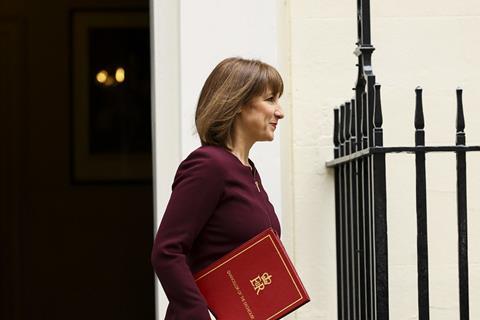While the Spring Statement brought no new developments for the pension sector, the UK’s fragile economic and fiscal situation means the state pension is under increasing scrutiny, as Pensions Expert explores.
Despite some speculation leading up to chancellor Rachel Reeves’ first Spring Statement, there was almost no mention of pensions in the announcement.
However, data from the Office for Budget Responsibility (OBR), published immediately before the chancellor’s address, shows that those in receipt of the state pension are approaching a tax “cliff edge” due to the effect of the triple lock.
Those in receipt of the new state pension could see their income increase by 4.6% in April 2026 due to the triple lock. However, with the tax-free personal allowance threshold remaining frozen, Quilter’s head of retirement policy Jon Greer said many pensioners could be forced to pay back some of their state pension income in tax.
“What was intended as a mechanism to protect pensioners from poverty is now colliding with fiscal drag,” Greer said. “This situation is the result of the triple lock producing some significant increases in the state pension due to high inflation and earning figures while the government has failed to uprate tax thresholds in tandem.”

In her first Budget as chancellor, Reeves said she would not change tax thresholds until 2028, but Greer said she could be forced to review this policy at the Autumn Statement later this year.
One of the Conservative Party’s major campaign issues in last year’s general election was taxation of pensions, with then-prime minister Rishi Sunak proposing a “triple lock plus” to keep the new state pension under the personal allowance.
The rising cost of the state pension
“Unless the government introduces means testing, the triple lock will cause payments to spiral out of control and the burden will balloon while the tax base shrinks.”
Edmund Greaves, Mouthy Money
Mike Ambery, retirement savings director at Standard Life, said the government was “walking a tightrope between existing spending commitments and its own fiscal rules” – with welfare spending in particular the subject of much discussion in recent days.
“At an annual cost of nearly £140bn the state pension would have been an attractive but politically fraught area for cost saving, particularly given the government’s manifesto commitment to the triple lock,” Ambery said.
“With March’s average earnings figure coming in at 5.8% including bonuses, there’s potential for a significant rise to the state pension in 2026. The sums of money involved are sure to make the state pension a focus of debate, but for now at least it is business as usual.”
Edmund Greaves, money expert from financial information platform Mouthy Money, said the state pension in its current form was “unsustainable”.
He added that current and previous governments had been “trying to finesse decades of unsustainable political promises” related to the state pension.
“Unless the government introduces means testing, the triple lock will cause payments to spiral out of control and the burden will balloon while the tax base shrinks,” Greaves argued.
The triple lock – change on the horizon?
Earlier this week, unnamed Labour MPs told the Daily Express that the triple lock had to be put under review at some point due to its huge cost to taxpayers. Jim O’Neill, former chair of Goldman Sachs and now a crossbench member of the House of Lords, has also reportedly called for the policy to be scrapped.
Former pensions minister Sir Steve Webb told The I Paper that almost every senior politician shared a similar view, that the triple lock should be changed or removed.
The Social Market Foundation, a think tank, last week urged the chancellor to review the triple lock to address its cost and potentially reduce the need to cut other welfare payments.
Sarah Brown, chief actuary at Gallagher’s benefits and HR consulting division, said the triple lock’s long-term viability was “clearly under increasing scrutiny”.
“The challenge is balancing fiscal responsibility while ensuring retirees have adequate incomes,” she said. “Although means-testing could cut costs by providing support to those who need it most, this comes with complex administrative hurdles.
“While reform seems inevitable, the real question is how we can keep the policy affordable as the costs mount up.”
Steven Hull, partner at law firm Burges Salmon, argued that there were “as many reasons to keep the triple lock as to remove it”.
The government may see higher pension incomes as a way to boost growth, as retirees generally had more time in which to spend it, Hull said. This was also a likely vote-winner.
However, the UK’s long-term demographic trend was leading towards a one-to-one ratio of economically active to economically inactive people.
“If Labour is serious about building a fairer and more sustainable system, it cannot ignore the long-term pressures the triple lock presents.”
Jon Greer, Quilter
Hull said this may lead more credence to the case for means testing the state pension due to “sheer lack of affordability”.
Quilter’s Greer said a review of the triple lock was “inevitable”. He suggested linking increases to earnings with “temporary CPI indexation” if inflation exceeds wage growth.
“Any change must be handled carefully,” he said. “The state pension is the single largest area of welfare spending and a vital source of income for millions. But if Labour is serious about building a fairer and more sustainable system, it cannot ignore the long-term pressures the triple lock presents.”
Steven Cameron, pensions director at Aegon, said the government could look at adapting the formula behind the triple lock, including introducing a “smoothing mechanism” to make state pension payments more predictable.
“Pensioners might receive an inflation increase as a minimum, and if, over the previous three years, wage growth has on average been higher than inflation, they could receive an additional uplift,” Cameron explained. “This would protect pensioner purchasing power and make future costs less unpredictable.”






 Earlier this week, unnamed Labour MPs told the Daily Express that the triple lock had to be put under review at some point due to its huge cost to taxpayers. Jim O’Neill, former chair of Goldman Sachs and now a crossbench member of the House of Lords, has also reportedly called for the policy to be scrapped.
Earlier this week, unnamed Labour MPs told the Daily Express that the triple lock had to be put under review at some point due to its huge cost to taxpayers. Jim O’Neill, former chair of Goldman Sachs and now a crossbench member of the House of Lords, has also reportedly called for the policy to be scrapped. 














